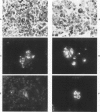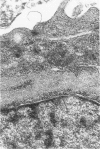Abstract
The majority of cells in a rapidly dividing human medulloblastoma cell line (D283 MED) are shown to express the two high-molecular-weight human neurofilament (NF) subunits, whereas a minority express the low-molecular-weight NF subunit. These three polypeptides are integral subunits of the intermediate filaments (IFs) found in normal neurons. Other cell type-specific IF proteins (keratin, desmin, and glial filament polypeptides) are not present in D283 MED cells. Further, the immunocytochemical, immunochemical and ultrastructural data suggest that the neurofilaments in these cells are abnormal, possibly because of a paucity of the low-molecular-weight NF subunit. This is the first human cell line derived from a central nervous system tumor that is capable of expressing all three NF triplet proteins. It is a unique model system for studies of normal and abnormal human NF metabolism as well as for probing the cell biology of medulloblastomas.
Full text
PDF





Images in this article
Selected References
These references are in PubMed. This may not be the complete list of references from this article.
- Asch B. B., Asch H. L. A keratin epitope that is exposed in a subpopulation of preneoplastic and neoplastic mouse mammary epithelial cells but not in normal cells. Cancer Res. 1986 Mar;46(3):1255–1262. [PubMed] [Google Scholar]
- Ben-Ze'ev A., Zöller M., Raz A. Differential expression of intermediate filament proteins in metastatic and nonmetastatic variants of the BSp73 tumor. Cancer Res. 1986 Feb;46(2):785–790. [PubMed] [Google Scholar]
- Bergh J., Nilsson K., Dahl D., Andersson L., Virtanen I., Lehto V. P. Expression of intermediate filaments in established human lung cancer cell lines. An indicator of differentiation and derivation. Lab Invest. 1984 Sep;51(3):307–316. [PubMed] [Google Scholar]
- Bunn C. L., White F. A., O'Guin W. M., Sawyer R. H., Knapp L. W. Intermediate filament expression and lifespan potential in human somatic cell hybrids. In Vitro Cell Dev Biol. 1985 Dec;21(12):716–720. doi: 10.1007/BF02620928. [DOI] [PubMed] [Google Scholar]
- Carden M. J., Schlaepfer W. W., Lee V. M. The structure, biochemical properties, and immunogenicity of neurofilament peripheral regions are determined by phosphorylation state. J Biol Chem. 1985 Aug 15;260(17):9805–9817. [PubMed] [Google Scholar]
- Celis J. E., Fey S. J., Larsen P. M., Celis A. Preferential phosphorylation of keratins and vimentin during mitosis in normal and transformed human amnion cells. Ann N Y Acad Sci. 1985;455:268–281. doi: 10.1111/j.1749-6632.1985.tb50417.x. [DOI] [PubMed] [Google Scholar]
- Friedman H. S., Burger P. C., Bigner S. H., Trojanowski J. Q., Wikstrand C. J., Halperin E. C., Bigner D. D. Establishment and characterization of the human medulloblastoma cell line and transplantable xenograft D283 Med. J Neuropathol Exp Neurol. 1985 Nov;44(6):592–605. doi: 10.1097/00005072-198511000-00005. [DOI] [PubMed] [Google Scholar]
- Gilles F. H. Classifications of childhood brain tumors. Cancer. 1985 Oct 1;56(7 Suppl):1850–1857. doi: 10.1002/1097-0142(19851001)56:7+<1850::aid-cncr2820561327>3.0.co;2-8. [DOI] [PubMed] [Google Scholar]
- Hirokawa N., Glicksman M. A., Willard M. B. Organization of mammalian neurofilament polypeptides within the neuronal cytoskeleton. J Cell Biol. 1984 Apr;98(4):1523–1536. doi: 10.1083/jcb.98.4.1523. [DOI] [PMC free article] [PubMed] [Google Scholar]
- Lee V. M., Andrews P. W. Differentiation of NTERA-2 clonal human embryonal carcinoma cells into neurons involves the induction of all three neurofilament proteins. J Neurosci. 1986 Feb;6(2):514–521. doi: 10.1523/JNEUROSCI.06-02-00514.1986. [DOI] [PMC free article] [PubMed] [Google Scholar]
- Lee V. M., Carden M. J., Schlaepfer W. W. Structural similarities and differences between neurofilament proteins from five different species as revealed using monoclonal antibodies. J Neurosci. 1986 Aug;6(8):2179–2186. doi: 10.1523/JNEUROSCI.06-08-02179.1986. [DOI] [PMC free article] [PubMed] [Google Scholar]
- Lee V. M., Carden M. J., Trojanowski J. Q. Novel monoclonal antibodies provide evidence for the in situ existence of a nonphosphorylated form of the largest neurofilament subunit. J Neurosci. 1986 Mar;6(3):850–858. doi: 10.1523/JNEUROSCI.06-03-00850.1986. [DOI] [PMC free article] [PubMed] [Google Scholar]
- Lee V. M. Neurofilament protein abnormalities in PC12 cells: comparison with neurofilament proteins of normal cultured rat sympathetic neurons. J Neurosci. 1985 Nov;5(11):3039–3046. doi: 10.1523/JNEUROSCI.05-11-03039.1985. [DOI] [PMC free article] [PubMed] [Google Scholar]
- Lee V. M., Page C. D., Wu H. L., Schlaepfer W. W. Monoclonal antibodies to gel-excised glial filament protein and their reactivities with other intermediate filament proteins. J Neurochem. 1984 Jan;42(1):25–32. doi: 10.1111/j.1471-4159.1984.tb09692.x. [DOI] [PubMed] [Google Scholar]
- Lee V., Trojanowski J. Q., Schlaepfer W. W. Induction of neurofilament triplet proteins in PC12 cells by nerve growth factor. Brain Res. 1982 Apr 22;238(1):169–180. doi: 10.1016/0006-8993(82)90779-x. [DOI] [PubMed] [Google Scholar]
- Roessmann U., Velasco M. E., Gambetti P., Autilio-Gambetti L. Neuronal and astrocytic differentiation in human neuroepithelial neoplasms. An immunohistochemical study. J Neuropathol Exp Neurol. 1983 Mar;42(2):113–121. doi: 10.1097/00005072-198303000-00001. [DOI] [PubMed] [Google Scholar]
- Rorke L. B., Gilles F. H., Davis R. L., Becker L. E. Revision of the World Health Organization classification of brain tumors for childhood brain tumors. Cancer. 1985 Oct 1;56(7 Suppl):1869–1886. doi: 10.1002/1097-0142(19851001)56:7+<1869::aid-cncr2820561330>3.0.co;2-0. [DOI] [PubMed] [Google Scholar]
- Rorke L. B., Gilles F. H., Davis R. L., Becker L. E. Revision of the World Health Organization classification of brain tumors for childhood brain tumors. Cancer. 1985 Oct 1;56(7 Suppl):1869–1886. doi: 10.1002/1097-0142(19851001)56:7+<1869::aid-cncr2820561330>3.0.co;2-0. [DOI] [PubMed] [Google Scholar]
- Schwob J. E., Farber N. B., Gottlieb D. I. Neurons of the olfactory epithelium in adult rats contain vimentin. J Neurosci. 1986 Jan;6(1):208–217. doi: 10.1523/JNEUROSCI.06-01-00208.1986. [DOI] [PMC free article] [PubMed] [Google Scholar]
- Tapscott S. J., Bennett G. S., Holtzer H. Neuronal precursor cells in the chick neural tube express neurofilament proteins. Nature. 1981 Aug 27;292(5826):836–838. doi: 10.1038/292836a0. [DOI] [PubMed] [Google Scholar]
- Tremblay G. F., Lee V. M., Trojanowski J. Q. Expression of vimentin, glial filament, and neurofilament proteins in primitive childhood brain tumors. A comparative immunoblot and immunoperoxidase study. Acta Neuropathol. 1985;68(3):239–244. doi: 10.1007/BF00690201. [DOI] [PubMed] [Google Scholar]
- Trojanowski J. Q., Obrocka M. A., Lee V. M. Distribution of neurofilament subunits in neurons and neuronal processes: immunohistochemical studies of bovine cerebellum with subunit-specific monoclonal antibodies. J Histochem Cytochem. 1985 Jun;33(6):557–563. doi: 10.1177/33.6.3889140. [DOI] [PubMed] [Google Scholar]
- Trojanowski J. Q., Walkenstein N., Lee V. M. Expression of neurofilament subunits in neurons of the central and peripheral nervous system: an immunohistochemical study with monoclonal antibodies. J Neurosci. 1986 Mar;6(3):650–660. doi: 10.1523/JNEUROSCI.06-03-00650.1986. [DOI] [PMC free article] [PubMed] [Google Scholar]
- Virtanen I., Miettinen M., Lehto V. P., Kariniemi A. L., Paasivuo R. Diagnostic application of monoclonal antibodies to intermediate filaments. Ann N Y Acad Sci. 1985;455:635–648. doi: 10.1111/j.1749-6632.1985.tb50441.x. [DOI] [PubMed] [Google Scholar]





